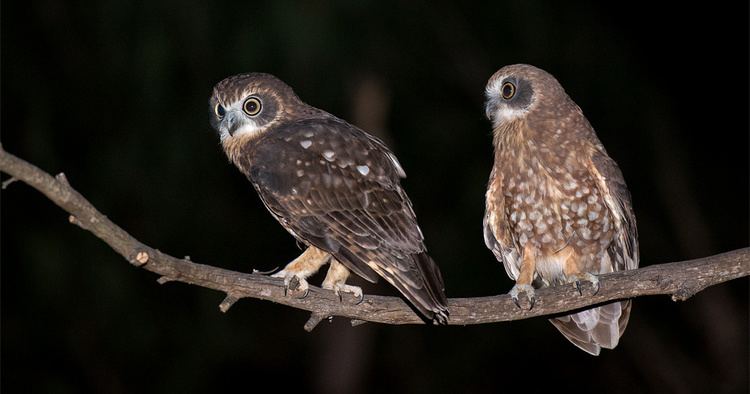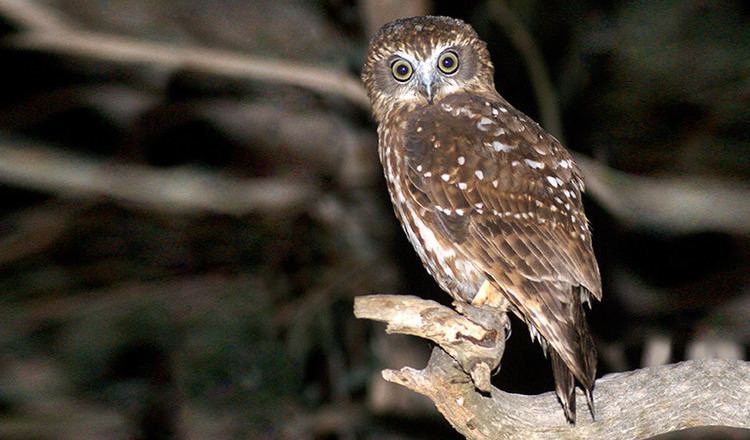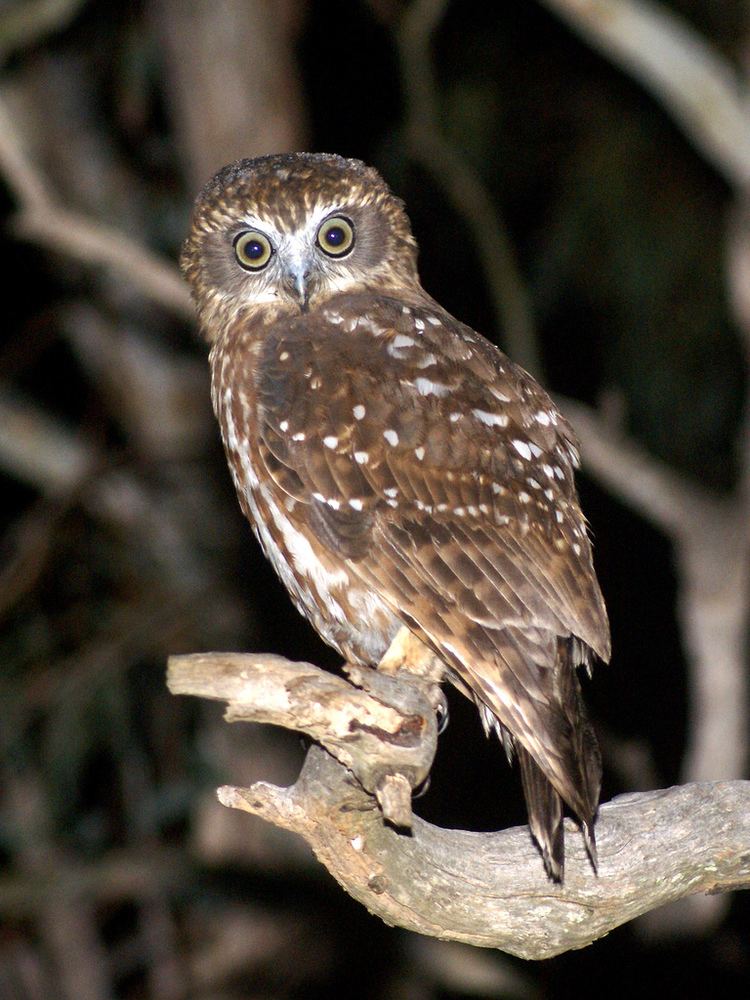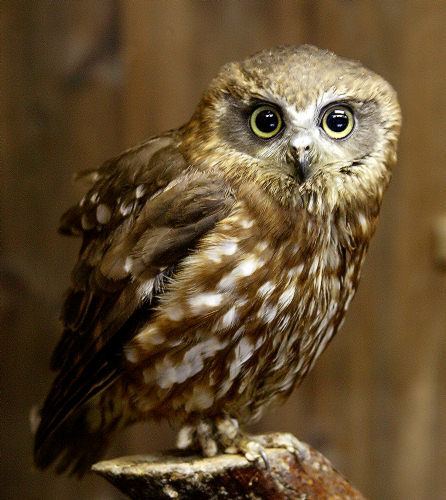Kingdom Animalia Order Strigiformes Genus Ninox Higher classification Ninox | Phylum Chordata Family Strigidae Scientific name Ninox boobook Rank Species | |
 | ||
Similar Owl, Bird, Ninox, Morepork, Barking owl | ||
Morepork or southern boobook owl at screech owl sanctury
The southern boobook (Ninox boobook) is a species of owl native to mainland Australia, southern New Guinea, Timor and the Sunda Islands. It was considered to be the same species (conspecific) as the morepork of New Zealand until 2013. Birds from Tasmania belong to a taxon, leucopsis which appear to be more closely related to (and hence treated as a subspecies of) the New Zealand species. Eleven subspecies are recognized. This bird is the smallest owl on the Australian mainland and is the continent's most widely distributed and common owl. It is predominantly brown in plumage with grey-green or yellow-green eyes. It feeds on insects and small vertebrates.
Contents
- Morepork or southern boobook owl at screech owl sanctury
- Taxonomy
- Subspecies
- Description
- Distribution and habitat
- Feeding
- Breeding
- Behavior
- References

Taxonomy

English ornithologist John Latham described the boobook owl as Strix boobook in 1801, taking its species epithet from a local Aboriginal word for the bird. John Gould described Athene marmorata in 1846 from a specimen in South Australia; this is now regarded as a synonym. In his 1865 Handbook to the Birds of Australia, Gould recognised three species, all of which he placed in the genus Spiloglaux: S. marmoratus from South Australia, S. boobook, which is widespread across the continent and Tasmania, and S. maculatus from southeastern Australia and Tasmania.

The common name comes from the two-tone call of the bird, and has also been transcribed as "mopoke". George Caley had recorded the native name as buck-buck during the earliest days of the colony, and reporting that early settlers had called it cuckoo owl as its call was reminiscent of the common cuckoo. However, he added, "The settlers in New South Wales are led away by the idea that everything is the reverse in that country to what it is in England; and the Cuckoo, as they call this bird, singing by night, is one of the instances they point out." Gould recorded local aboriginal names: Goor-goor-da (Western Australia), Mel-in-de-ye (Port Essington), and Koor-koo (South Australia). Alternative common names include spotted owl and brown owl.

Both Gerlof Fokko Mees and Ernst Mayr regarded the taxonomy of the boobook owl as extremely challenging, the latter remarking that it was "one of the most difficult problems I have ever encountered".

In a 1998 paper, Janette Norman and colleagues tested the cytochrome b DNA of three subspecies (as well as the powerful and rufous owls) to ascertain whether the closest relative was used in breeding with the last surviving female of the Norfolk boobook. They discovered that although the Norfolk boobook is similar in plumage to the Tasmanian boobook, that it is genetically much closer to the New Zealand morepork. In fact, the two are so close genetically that they considered whether the Norfolk boobook should be recognised as a separate taxon at all, though conceded they are easily distinguishable in appearance and so maintained the three as subspecies; the Tasmanian boobook only diverged by 2.7% from the other two, while the powerful and rufous owls diverged by 4.4% from each other. Leading from this, the southern boobook was split from the Tasmanian boobook and morepork in volume 5 of the Handbook of the Birds of the World; however, several authors, including Les Christidis and Walter Boles, contended that the data from the Norman study, which had not sampled any Australian mainland boobooks at all, had been misinterpreted. They treated the three taxa (southern plus Tasmanian boobooks and moreporks) as a single species.

Examining both morphological and genetic (cytochrome b) characters, Michael Wink and colleagues concluded that the southern boobook is distinct from the morepork and Tasmanian boobook (which should be raised to species status as Ninox leucopsis), and that it is instead the sister taxon to the barking owl (N. connivens).
Subspecies
Eleven subspecies are recognised:
Description
The smallest owl on the Australian mainland, the southern boobook is 27–36 cm long. The nominate subspecies is the largest. Southern boobooks on the Australian mainland follow Bergmann's rule, in that birds from more southerly parts of the range tend to be larger. Thus birds from the Canberra region weigh around 300 g while those from Cape York and Broome are around 200 g. However, the Tasmanian boobook and New Zealand morepork are also small.
The southern boobook has generally brown head and upperparts, with white markings on the scapulars and spots on the wings. Its head lacks tufts common in other owls, and has a paler facial disk with darker feathers behind the eyes. The eyes have been described as grey-green, green-yellow, or even light hazel, distinct from the Tasmanian and New Zealand species that have golden eyes. The underparts are paler, ranging from buff to cream, and are streaked with brown. The overall colour is variable and does not appear to correspond to subspecies or region. In northern and central Australia, Mayr found that the colour of the plumage appears to correlate with the rainfall or humidity, paler birds being found in three disjunct areas, each around 1,600 kilometres (990 mi) away from the other two: the western Kimberley and Pilbara, Sedan on the Cloncurry River, and around Ooldea, with darker birds found on Cape York and Melville Island.
Distribution and habitat
The southern boobook is found across Australia, except in the most arid desert regions, and into southern New Guinea, Roti, Timor and surrounding islands in Indonesia. It is found in a wide range of habitats, from forest and open woodland to scrubland and semi-desert areas. In Australia it resides in mainly Eucalypt forests. It has adapted to landscapes altered by human activity and is found in farmland and suburban areas as long as there are some scattered trees.
Feeding
The southern boobook generally preys on insects, particularly nocturnal beetles and moths, mice, and birds the size of a house sparrow. A higher proportion of its diet is invertebrates compared with other Australian owls. Fieldwork in the vicinity of Canberra found that vertebrates made up more of the diet in autumn and winter. A study in Victoria found that larger animals were eaten, including Baillon's crake, common ringtail possum and feral rabbit. It uses a fence, branch or telegraph pole as a perch or vantage point to hunt from.
Breeding
The southern boobook nests in holes in trees between one and twenty metres above the ground.
Behavior
The Southern Boobook is a nocturnal species. It is mainly solitary but it does have calls to other birds of its species. It is territorial and does not move habitats very often in its lifetime.
